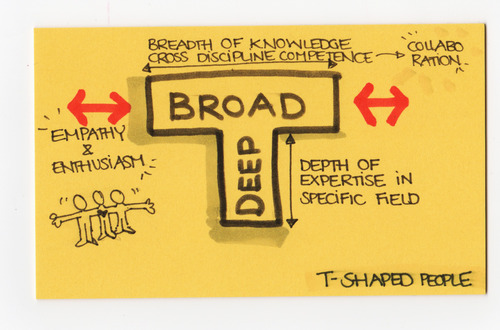shape up for Innovation: Become more t-shaped

Innovation occurs at the intersection of disciplines and needs radical collaboration between people with very different backgrounds and viewpoints. Tim Brown introduced the term "T-shaped" to describe people who have depth of skills and experience in one discipline, represented by the vertical stroke, while also having a broad understanding and experience in various disciplines, represented by the horizontal stroke.
A breadth of knowledge and cross disciplinary competence provide empathy for other disciplines and sets the stage for a fruitful collaboration. Empathy allows us to imagine the problem from another perspective, to walk in somebody else's shoes. People with cross discipline competence are open and enthusiastic about other people's disciplines. This is very valuable in collaboration, as people add onto the ideas of others, as they listen carefully and ask the right questions, this is when the magic of teamwork happens and the ideas, that many brains worked on start to soar.
On the other hand I-shaped individuals have a hard time with collaboration. What tends to happen is that each discipline presents its own solution. Collaboration becomes a negotiation as to whose idea wins.
I talked to Judith Anderson, Department Chair of Industrial Design at the Massachusetts College of Art and Design, Boston about the role Design Thinking plays in today's Design education. Last semester, MassArt for the first time had set up an undergraduate design collaborative course in corporation with Olin College of Engineering/Needham and Babson Business School/Wellesley. What became evident during this class was, that the vertical stroke of the 'T' has to have a certain amount of confidence and comfort and that collaboration is very hard to teach within our current grading model & student's experience. As Judith puts it; "Design thinking is a tool to speak cross discipline. One of the most important skills for a designer in the coming years is to understand how to work respectfully with other disciplines towards a common goal- we need to leave our egos at the door ask more questions and listen more intently.'
To wrap it up, becoming more T-shaped is good advice in our interconnected world, it enriches communication, collaboration and opens doors to other disciplines. Designers especially need to stay curious, broaden their skill set across other disciplines (especially across other design disciplines) and become life long learners in a world, where knowledge is a key resource.
- Created on .